Integrated Marketing Communication Plan: Nestle Uncle Toby's
VerifiedAdded on 2023/06/04
|8
|1774
|356
Project
AI Summary
This assignment presents an Integrated Marketing Communication (IMC) plan for Nestle's Uncle Toby's brand, covering a thorough situation analysis, including external (industry, competitor, consumer) and internal (company, products, SWOT) factors. It proposes brief marketing objectives focusing on market share and sales volume, followed by a detailed profiling of the target audience and justification for the selected communication campaign focus. The plan outlines communication objectives and a comprehensive IMC strategy, including creative and media strategies, with a media schedule and budget considerations. The assignment also covers monitoring and evaluation methods, providing a complete marketing communication strategy for the brand. The analysis is based on the provided assignment brief that outlines the need for an IMC plan to address the challenges and opportunities for the Uncle Toby's brand in the Australian market.
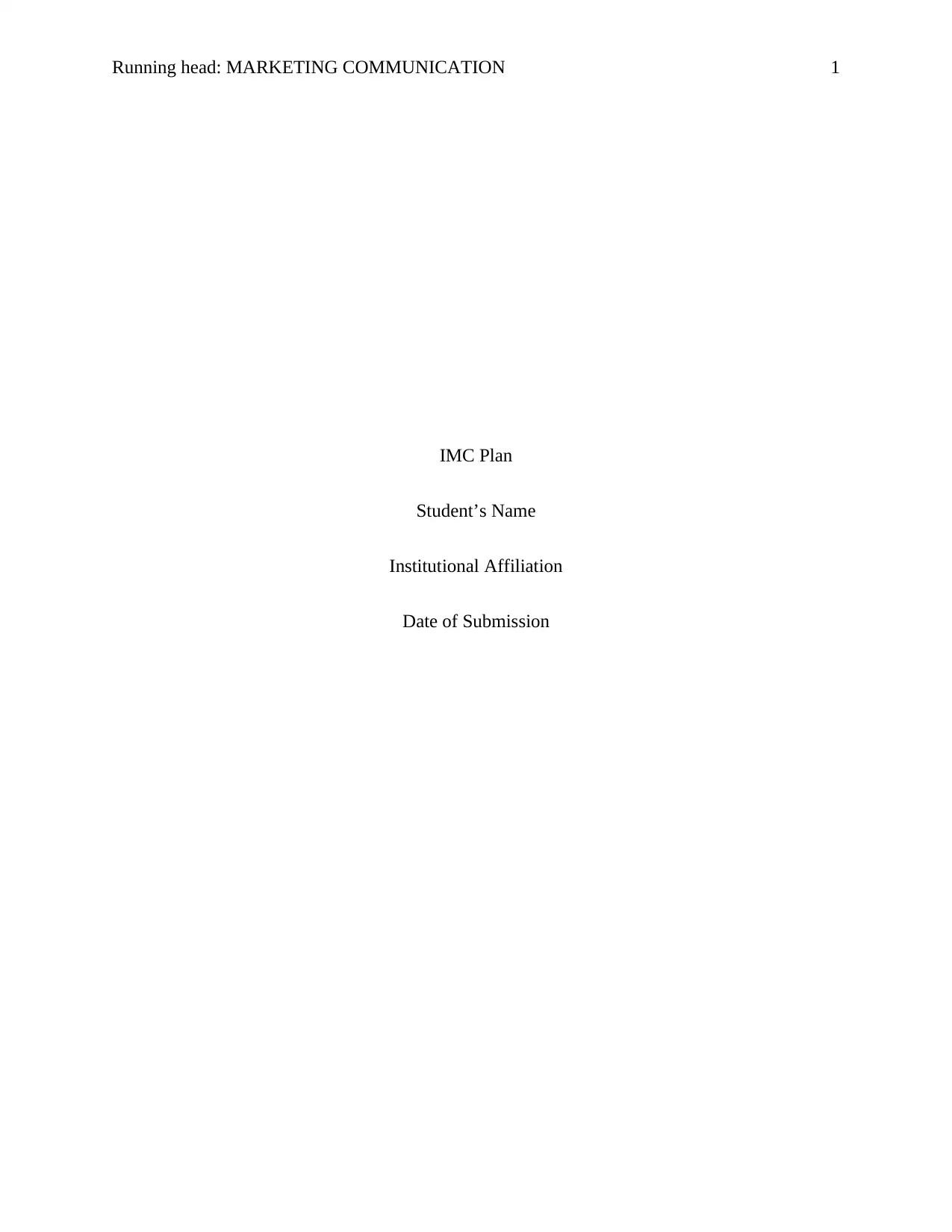
Running head: MARKETING COMMUNICATION 1
IMC Plan
Student’s Name
Institutional Affiliation
Date of Submission
IMC Plan
Student’s Name
Institutional Affiliation
Date of Submission
Paraphrase This Document
Need a fresh take? Get an instant paraphrase of this document with our AI Paraphraser
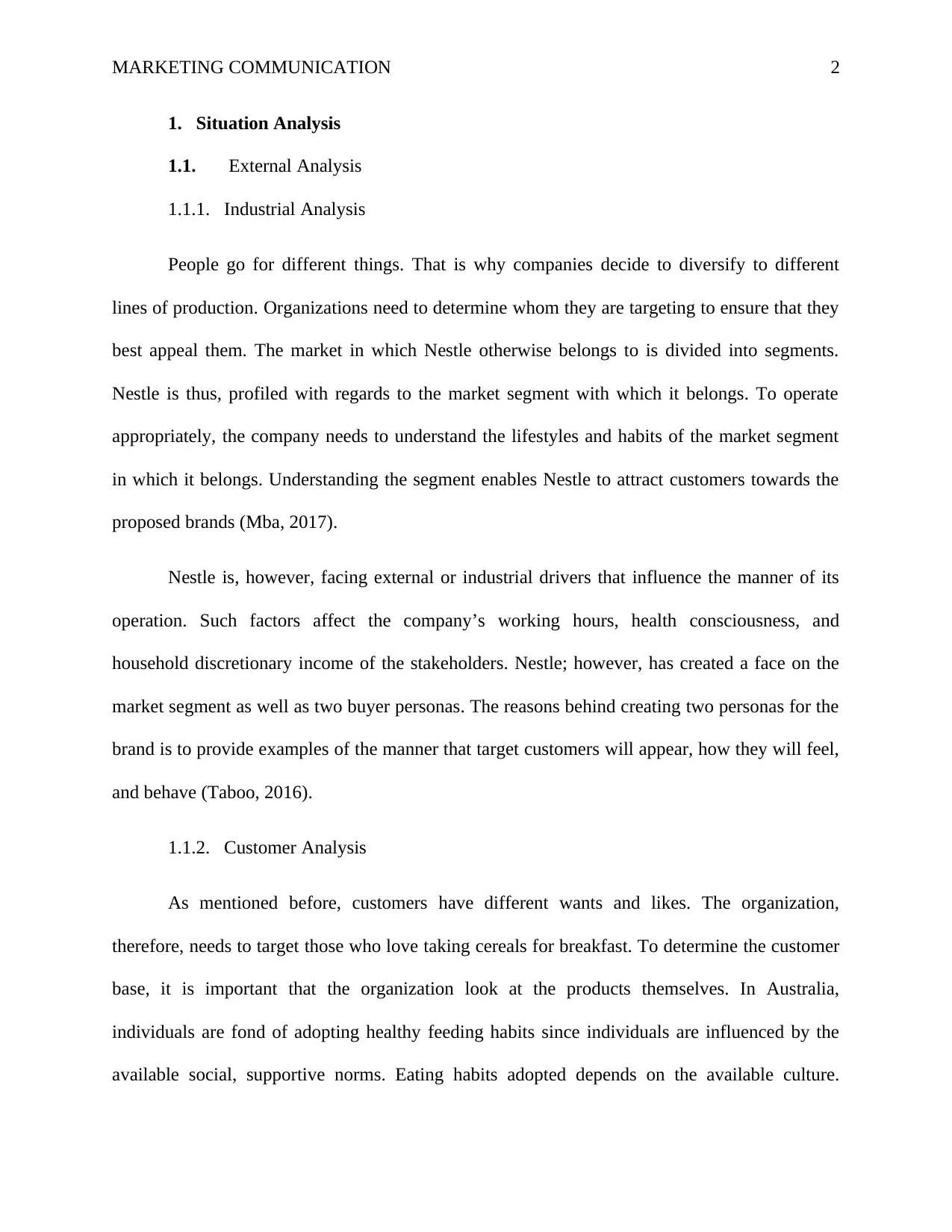
MARKETING COMMUNICATION 2
1. Situation Analysis
1.1. External Analysis
1.1.1. Industrial Analysis
People go for different things. That is why companies decide to diversify to different
lines of production. Organizations need to determine whom they are targeting to ensure that they
best appeal them. The market in which Nestle otherwise belongs to is divided into segments.
Nestle is thus, profiled with regards to the market segment with which it belongs. To operate
appropriately, the company needs to understand the lifestyles and habits of the market segment
in which it belongs. Understanding the segment enables Nestle to attract customers towards the
proposed brands (Mba, 2017).
Nestle is, however, facing external or industrial drivers that influence the manner of its
operation. Such factors affect the company’s working hours, health consciousness, and
household discretionary income of the stakeholders. Nestle; however, has created a face on the
market segment as well as two buyer personas. The reasons behind creating two personas for the
brand is to provide examples of the manner that target customers will appear, how they will feel,
and behave (Taboo, 2016).
1.1.2. Customer Analysis
As mentioned before, customers have different wants and likes. The organization,
therefore, needs to target those who love taking cereals for breakfast. To determine the customer
base, it is important that the organization look at the products themselves. In Australia,
individuals are fond of adopting healthy feeding habits since individuals are influenced by the
available social, supportive norms. Eating habits adopted depends on the available culture.
1. Situation Analysis
1.1. External Analysis
1.1.1. Industrial Analysis
People go for different things. That is why companies decide to diversify to different
lines of production. Organizations need to determine whom they are targeting to ensure that they
best appeal them. The market in which Nestle otherwise belongs to is divided into segments.
Nestle is thus, profiled with regards to the market segment with which it belongs. To operate
appropriately, the company needs to understand the lifestyles and habits of the market segment
in which it belongs. Understanding the segment enables Nestle to attract customers towards the
proposed brands (Mba, 2017).
Nestle is, however, facing external or industrial drivers that influence the manner of its
operation. Such factors affect the company’s working hours, health consciousness, and
household discretionary income of the stakeholders. Nestle; however, has created a face on the
market segment as well as two buyer personas. The reasons behind creating two personas for the
brand is to provide examples of the manner that target customers will appear, how they will feel,
and behave (Taboo, 2016).
1.1.2. Customer Analysis
As mentioned before, customers have different wants and likes. The organization,
therefore, needs to target those who love taking cereals for breakfast. To determine the customer
base, it is important that the organization look at the products themselves. In Australia,
individuals are fond of adopting healthy feeding habits since individuals are influenced by the
available social, supportive norms. Eating habits adopted depends on the available culture.
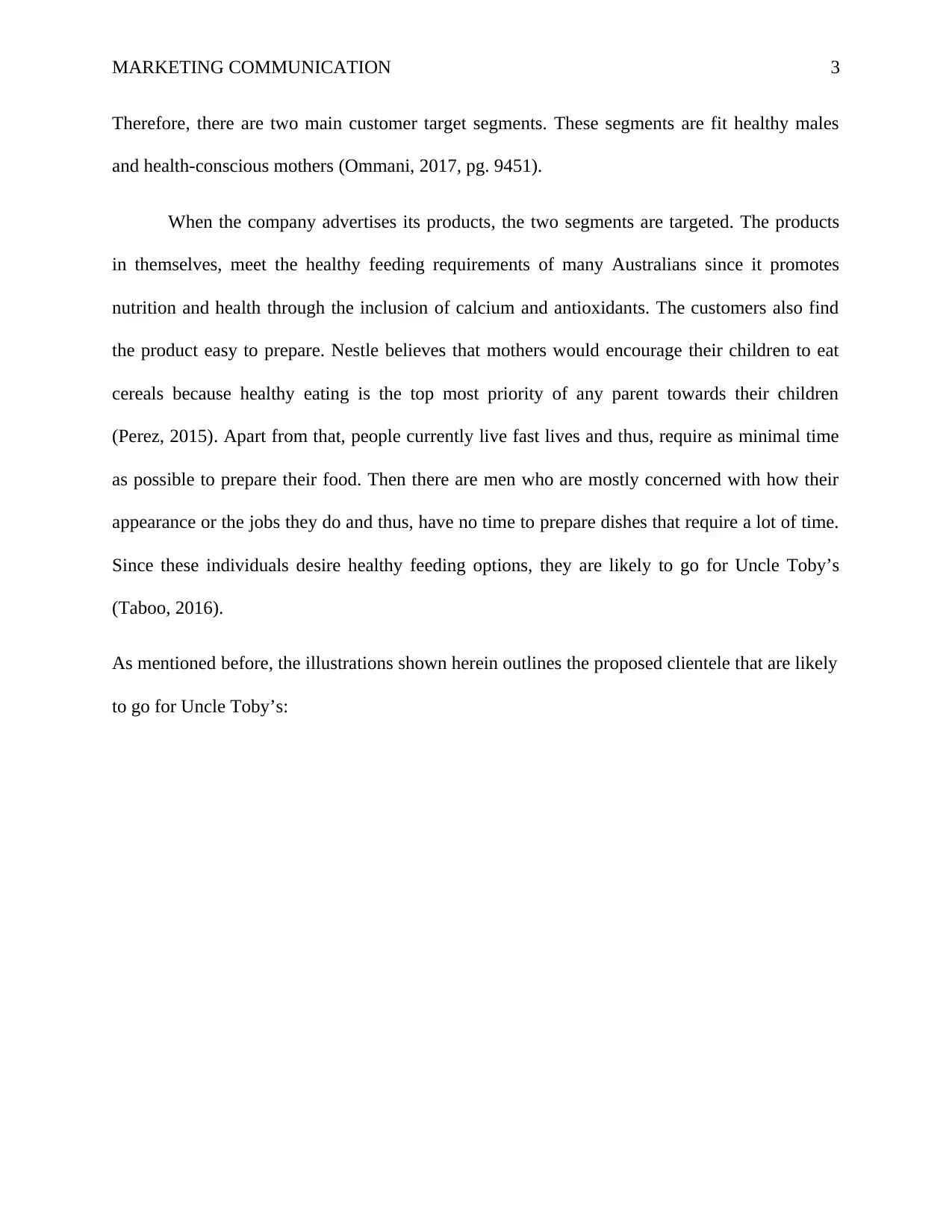
MARKETING COMMUNICATION 3
Therefore, there are two main customer target segments. These segments are fit healthy males
and health-conscious mothers (Ommani, 2017, pg. 9451).
When the company advertises its products, the two segments are targeted. The products
in themselves, meet the healthy feeding requirements of many Australians since it promotes
nutrition and health through the inclusion of calcium and antioxidants. The customers also find
the product easy to prepare. Nestle believes that mothers would encourage their children to eat
cereals because healthy eating is the top most priority of any parent towards their children
(Perez, 2015). Apart from that, people currently live fast lives and thus, require as minimal time
as possible to prepare their food. Then there are men who are mostly concerned with how their
appearance or the jobs they do and thus, have no time to prepare dishes that require a lot of time.
Since these individuals desire healthy feeding options, they are likely to go for Uncle Toby’s
(Taboo, 2016).
As mentioned before, the illustrations shown herein outlines the proposed clientele that are likely
to go for Uncle Toby’s:
Therefore, there are two main customer target segments. These segments are fit healthy males
and health-conscious mothers (Ommani, 2017, pg. 9451).
When the company advertises its products, the two segments are targeted. The products
in themselves, meet the healthy feeding requirements of many Australians since it promotes
nutrition and health through the inclusion of calcium and antioxidants. The customers also find
the product easy to prepare. Nestle believes that mothers would encourage their children to eat
cereals because healthy eating is the top most priority of any parent towards their children
(Perez, 2015). Apart from that, people currently live fast lives and thus, require as minimal time
as possible to prepare their food. Then there are men who are mostly concerned with how their
appearance or the jobs they do and thus, have no time to prepare dishes that require a lot of time.
Since these individuals desire healthy feeding options, they are likely to go for Uncle Toby’s
(Taboo, 2016).
As mentioned before, the illustrations shown herein outlines the proposed clientele that are likely
to go for Uncle Toby’s:
⊘ This is a preview!⊘
Do you want full access?
Subscribe today to unlock all pages.

Trusted by 1+ million students worldwide
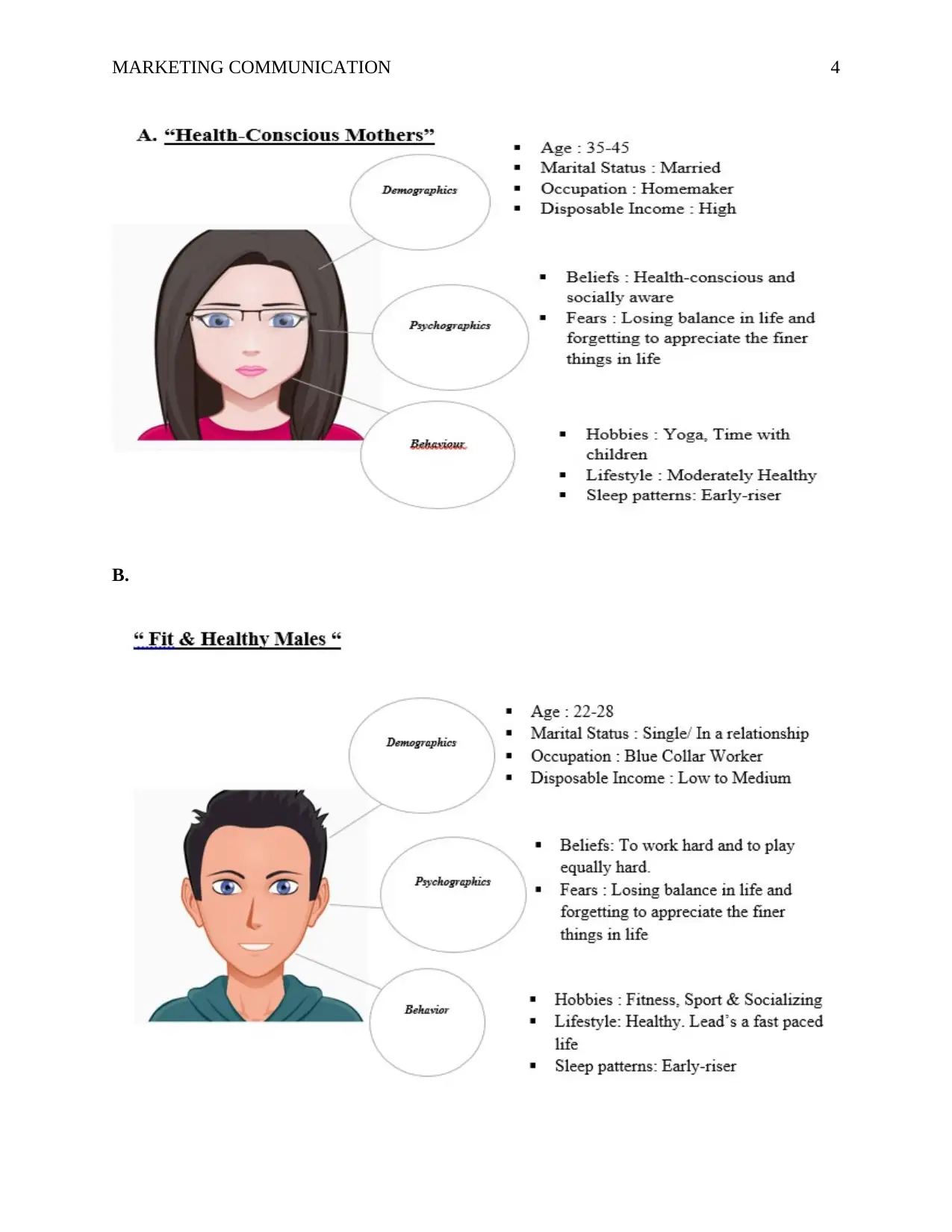
MARKETING COMMUNICATION 4
B.
B.
Paraphrase This Document
Need a fresh take? Get an instant paraphrase of this document with our AI Paraphraser
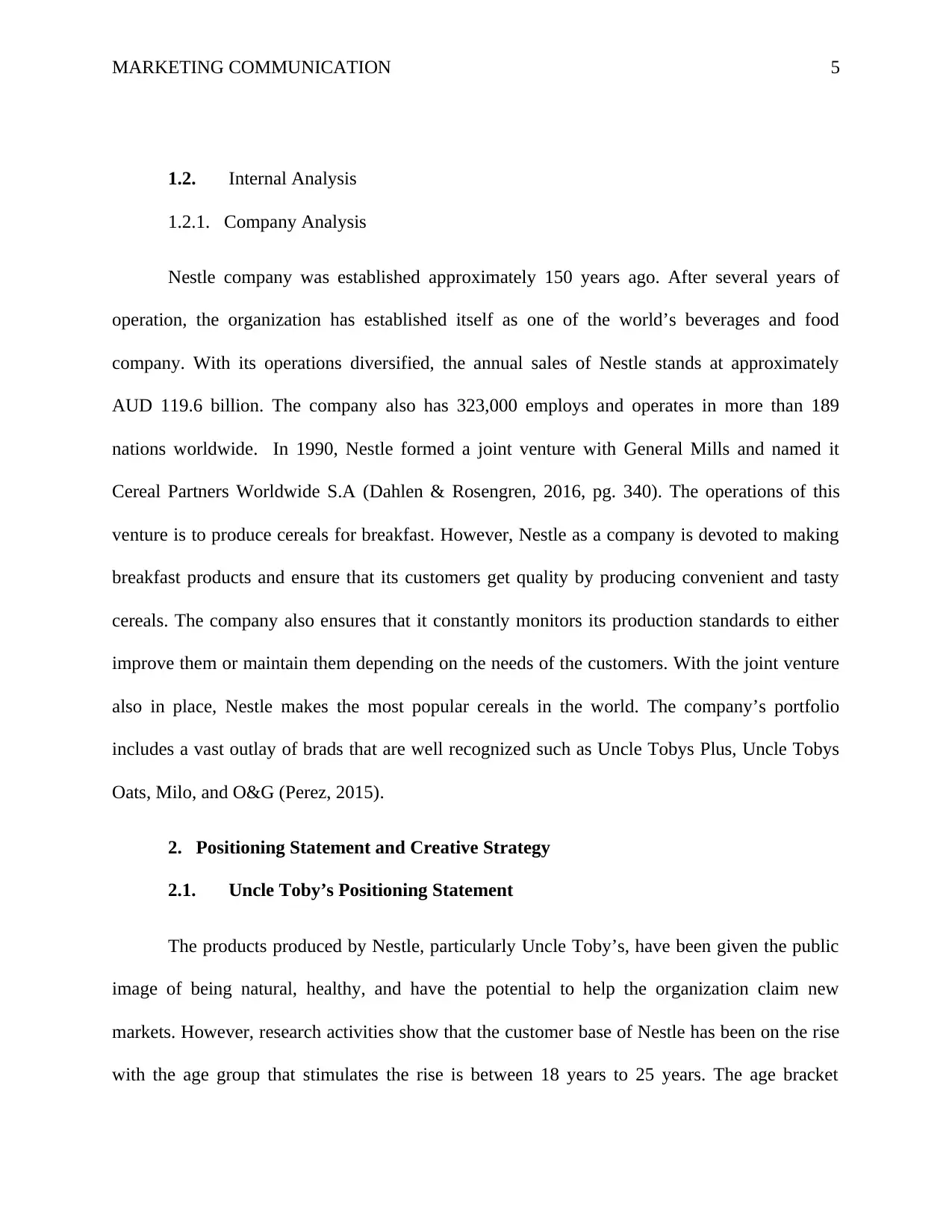
MARKETING COMMUNICATION 5
1.2. Internal Analysis
1.2.1. Company Analysis
Nestle company was established approximately 150 years ago. After several years of
operation, the organization has established itself as one of the world’s beverages and food
company. With its operations diversified, the annual sales of Nestle stands at approximately
AUD 119.6 billion. The company also has 323,000 employs and operates in more than 189
nations worldwide. In 1990, Nestle formed a joint venture with General Mills and named it
Cereal Partners Worldwide S.A (Dahlen & Rosengren, 2016, pg. 340). The operations of this
venture is to produce cereals for breakfast. However, Nestle as a company is devoted to making
breakfast products and ensure that its customers get quality by producing convenient and tasty
cereals. The company also ensures that it constantly monitors its production standards to either
improve them or maintain them depending on the needs of the customers. With the joint venture
also in place, Nestle makes the most popular cereals in the world. The company’s portfolio
includes a vast outlay of brads that are well recognized such as Uncle Tobys Plus, Uncle Tobys
Oats, Milo, and O&G (Perez, 2015).
2. Positioning Statement and Creative Strategy
2.1. Uncle Toby’s Positioning Statement
The products produced by Nestle, particularly Uncle Toby’s, have been given the public
image of being natural, healthy, and have the potential to help the organization claim new
markets. However, research activities show that the customer base of Nestle has been on the rise
with the age group that stimulates the rise is between 18 years to 25 years. The age bracket
1.2. Internal Analysis
1.2.1. Company Analysis
Nestle company was established approximately 150 years ago. After several years of
operation, the organization has established itself as one of the world’s beverages and food
company. With its operations diversified, the annual sales of Nestle stands at approximately
AUD 119.6 billion. The company also has 323,000 employs and operates in more than 189
nations worldwide. In 1990, Nestle formed a joint venture with General Mills and named it
Cereal Partners Worldwide S.A (Dahlen & Rosengren, 2016, pg. 340). The operations of this
venture is to produce cereals for breakfast. However, Nestle as a company is devoted to making
breakfast products and ensure that its customers get quality by producing convenient and tasty
cereals. The company also ensures that it constantly monitors its production standards to either
improve them or maintain them depending on the needs of the customers. With the joint venture
also in place, Nestle makes the most popular cereals in the world. The company’s portfolio
includes a vast outlay of brads that are well recognized such as Uncle Tobys Plus, Uncle Tobys
Oats, Milo, and O&G (Perez, 2015).
2. Positioning Statement and Creative Strategy
2.1. Uncle Toby’s Positioning Statement
The products produced by Nestle, particularly Uncle Toby’s, have been given the public
image of being natural, healthy, and have the potential to help the organization claim new
markets. However, research activities show that the customer base of Nestle has been on the rise
with the age group that stimulates the rise is between 18 years to 25 years. The age bracket
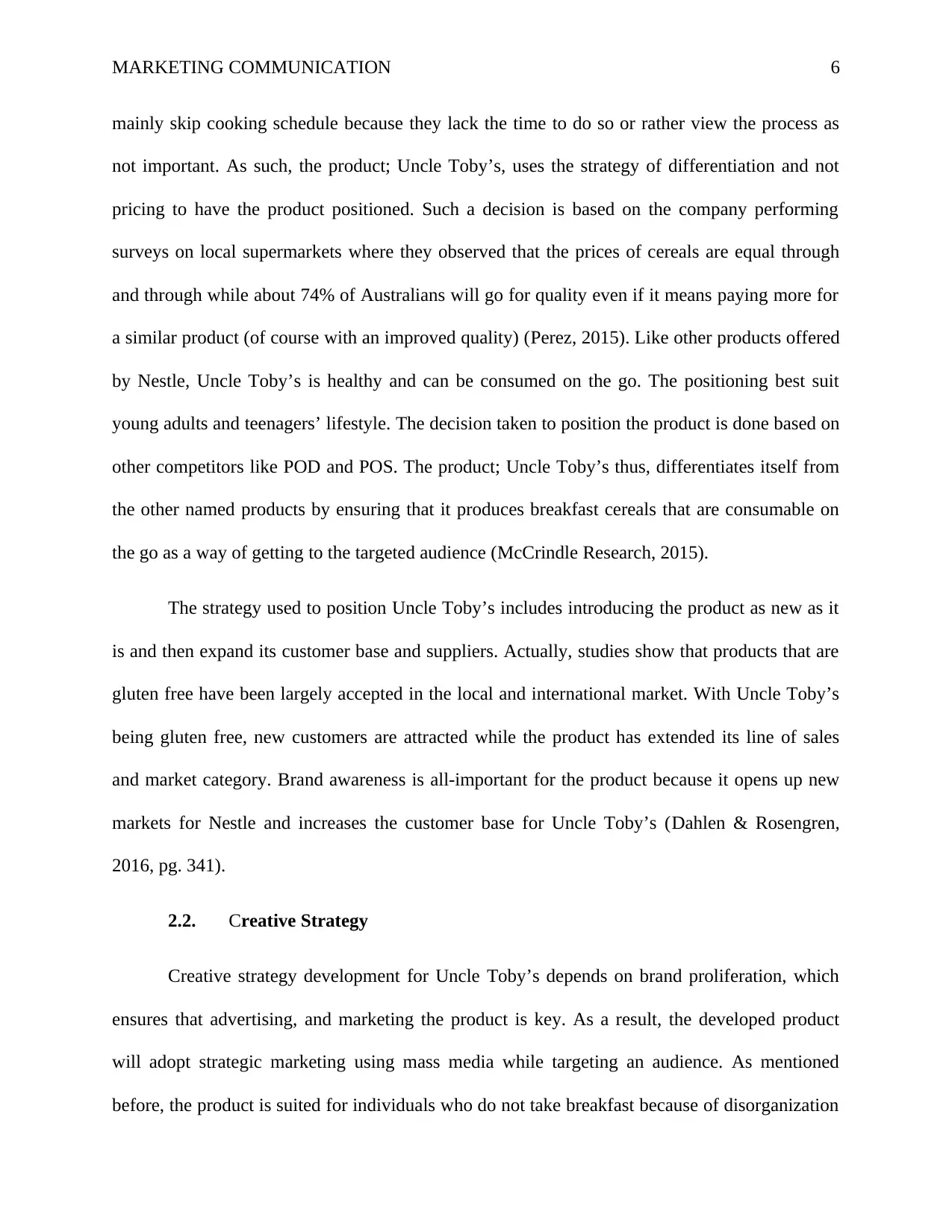
MARKETING COMMUNICATION 6
mainly skip cooking schedule because they lack the time to do so or rather view the process as
not important. As such, the product; Uncle Toby’s, uses the strategy of differentiation and not
pricing to have the product positioned. Such a decision is based on the company performing
surveys on local supermarkets where they observed that the prices of cereals are equal through
and through while about 74% of Australians will go for quality even if it means paying more for
a similar product (of course with an improved quality) (Perez, 2015). Like other products offered
by Nestle, Uncle Toby’s is healthy and can be consumed on the go. The positioning best suit
young adults and teenagers’ lifestyle. The decision taken to position the product is done based on
other competitors like POD and POS. The product; Uncle Toby’s thus, differentiates itself from
the other named products by ensuring that it produces breakfast cereals that are consumable on
the go as a way of getting to the targeted audience (McCrindle Research, 2015).
The strategy used to position Uncle Toby’s includes introducing the product as new as it
is and then expand its customer base and suppliers. Actually, studies show that products that are
gluten free have been largely accepted in the local and international market. With Uncle Toby’s
being gluten free, new customers are attracted while the product has extended its line of sales
and market category. Brand awareness is all-important for the product because it opens up new
markets for Nestle and increases the customer base for Uncle Toby’s (Dahlen & Rosengren,
2016, pg. 341).
2.2. Creative Strategy
Creative strategy development for Uncle Toby’s depends on brand proliferation, which
ensures that advertising, and marketing the product is key. As a result, the developed product
will adopt strategic marketing using mass media while targeting an audience. As mentioned
before, the product is suited for individuals who do not take breakfast because of disorganization
mainly skip cooking schedule because they lack the time to do so or rather view the process as
not important. As such, the product; Uncle Toby’s, uses the strategy of differentiation and not
pricing to have the product positioned. Such a decision is based on the company performing
surveys on local supermarkets where they observed that the prices of cereals are equal through
and through while about 74% of Australians will go for quality even if it means paying more for
a similar product (of course with an improved quality) (Perez, 2015). Like other products offered
by Nestle, Uncle Toby’s is healthy and can be consumed on the go. The positioning best suit
young adults and teenagers’ lifestyle. The decision taken to position the product is done based on
other competitors like POD and POS. The product; Uncle Toby’s thus, differentiates itself from
the other named products by ensuring that it produces breakfast cereals that are consumable on
the go as a way of getting to the targeted audience (McCrindle Research, 2015).
The strategy used to position Uncle Toby’s includes introducing the product as new as it
is and then expand its customer base and suppliers. Actually, studies show that products that are
gluten free have been largely accepted in the local and international market. With Uncle Toby’s
being gluten free, new customers are attracted while the product has extended its line of sales
and market category. Brand awareness is all-important for the product because it opens up new
markets for Nestle and increases the customer base for Uncle Toby’s (Dahlen & Rosengren,
2016, pg. 341).
2.2. Creative Strategy
Creative strategy development for Uncle Toby’s depends on brand proliferation, which
ensures that advertising, and marketing the product is key. As a result, the developed product
will adopt strategic marketing using mass media while targeting an audience. As mentioned
before, the product is suited for individuals who do not take breakfast because of disorganization
⊘ This is a preview!⊘
Do you want full access?
Subscribe today to unlock all pages.

Trusted by 1+ million students worldwide
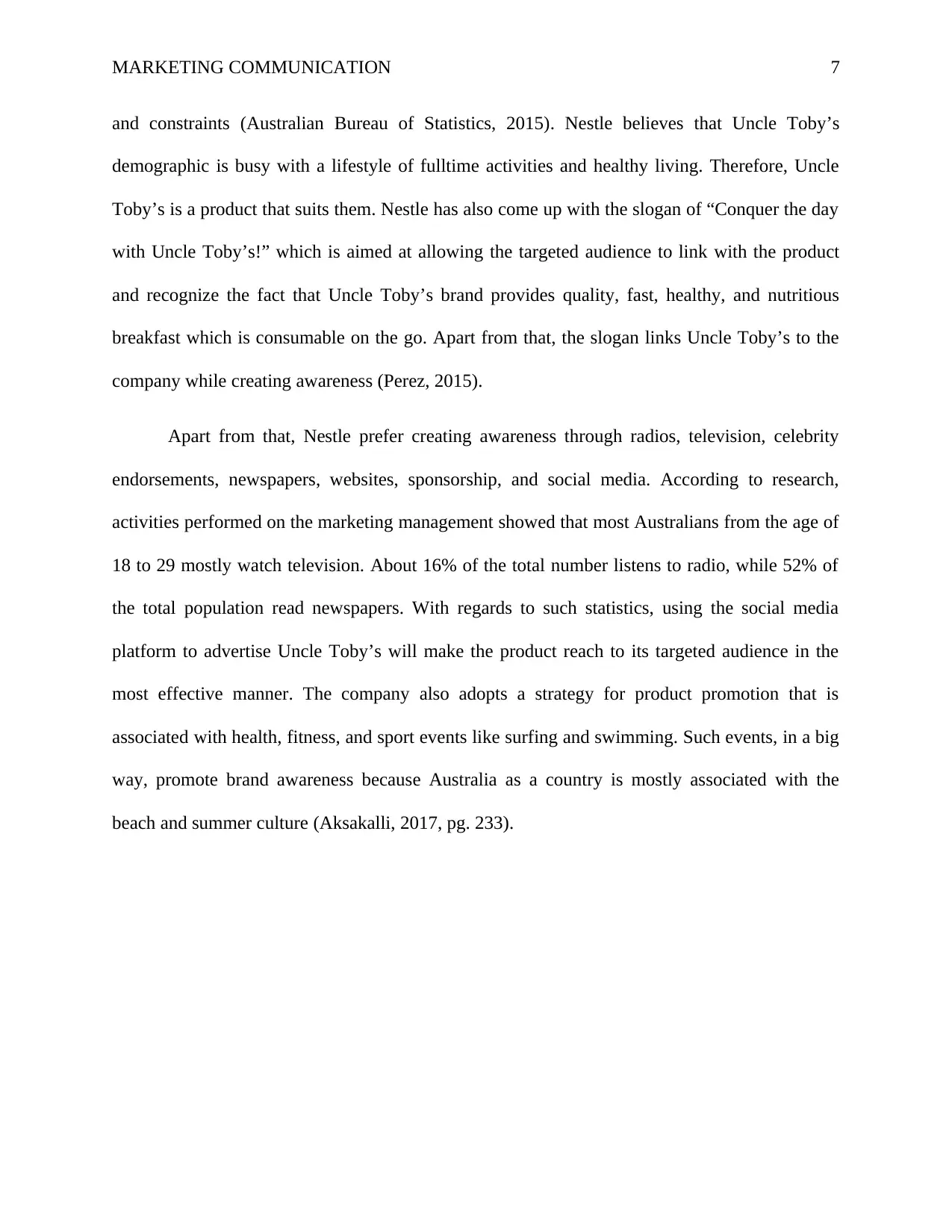
MARKETING COMMUNICATION 7
and constraints (Australian Bureau of Statistics, 2015). Nestle believes that Uncle Toby’s
demographic is busy with a lifestyle of fulltime activities and healthy living. Therefore, Uncle
Toby’s is a product that suits them. Nestle has also come up with the slogan of “Conquer the day
with Uncle Toby’s!” which is aimed at allowing the targeted audience to link with the product
and recognize the fact that Uncle Toby’s brand provides quality, fast, healthy, and nutritious
breakfast which is consumable on the go. Apart from that, the slogan links Uncle Toby’s to the
company while creating awareness (Perez, 2015).
Apart from that, Nestle prefer creating awareness through radios, television, celebrity
endorsements, newspapers, websites, sponsorship, and social media. According to research,
activities performed on the marketing management showed that most Australians from the age of
18 to 29 mostly watch television. About 16% of the total number listens to radio, while 52% of
the total population read newspapers. With regards to such statistics, using the social media
platform to advertise Uncle Toby’s will make the product reach to its targeted audience in the
most effective manner. The company also adopts a strategy for product promotion that is
associated with health, fitness, and sport events like surfing and swimming. Such events, in a big
way, promote brand awareness because Australia as a country is mostly associated with the
beach and summer culture (Aksakalli, 2017, pg. 233).
and constraints (Australian Bureau of Statistics, 2015). Nestle believes that Uncle Toby’s
demographic is busy with a lifestyle of fulltime activities and healthy living. Therefore, Uncle
Toby’s is a product that suits them. Nestle has also come up with the slogan of “Conquer the day
with Uncle Toby’s!” which is aimed at allowing the targeted audience to link with the product
and recognize the fact that Uncle Toby’s brand provides quality, fast, healthy, and nutritious
breakfast which is consumable on the go. Apart from that, the slogan links Uncle Toby’s to the
company while creating awareness (Perez, 2015).
Apart from that, Nestle prefer creating awareness through radios, television, celebrity
endorsements, newspapers, websites, sponsorship, and social media. According to research,
activities performed on the marketing management showed that most Australians from the age of
18 to 29 mostly watch television. About 16% of the total number listens to radio, while 52% of
the total population read newspapers. With regards to such statistics, using the social media
platform to advertise Uncle Toby’s will make the product reach to its targeted audience in the
most effective manner. The company also adopts a strategy for product promotion that is
associated with health, fitness, and sport events like surfing and swimming. Such events, in a big
way, promote brand awareness because Australia as a country is mostly associated with the
beach and summer culture (Aksakalli, 2017, pg. 233).
Paraphrase This Document
Need a fresh take? Get an instant paraphrase of this document with our AI Paraphraser
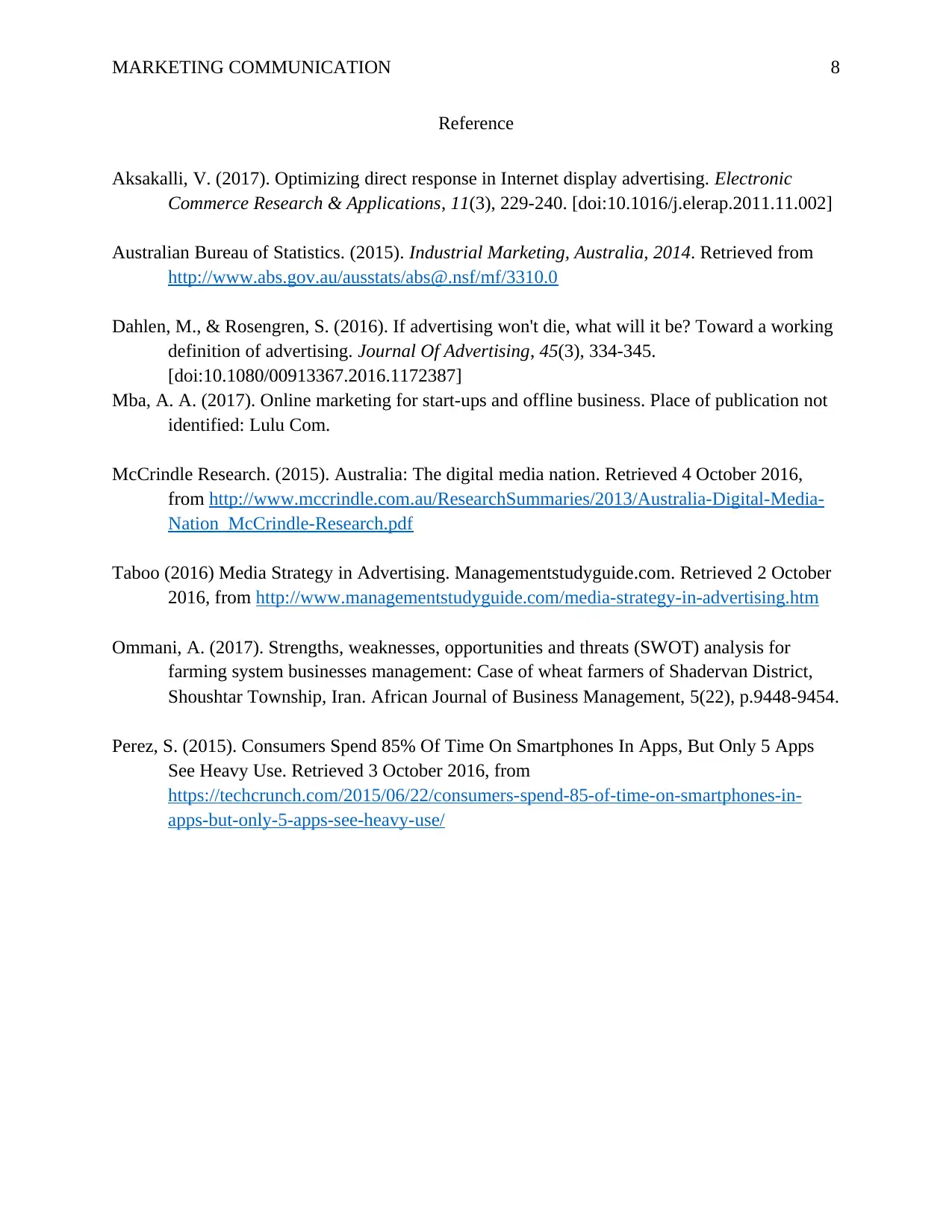
MARKETING COMMUNICATION 8
Reference
Aksakalli, V. (2017). Optimizing direct response in Internet display advertising. Electronic
Commerce Research & Applications, 11(3), 229-240. [doi:10.1016/j.elerap.2011.11.002]
Australian Bureau of Statistics. (2015). Industrial Marketing, Australia, 2014. Retrieved from
http://www.abs.gov.au/ausstats/abs@.nsf/mf/3310.0
Dahlen, M., & Rosengren, S. (2016). If advertising won't die, what will it be? Toward a working
definition of advertising. Journal Of Advertising, 45(3), 334-345.
[doi:10.1080/00913367.2016.1172387]
Mba, A. A. (2017). Online marketing for start-ups and offline business. Place of publication not
identified: Lulu Com.
McCrindle Research. (2015). Australia: The digital media nation. Retrieved 4 October 2016,
from http://www.mccrindle.com.au/ResearchSummaries/2013/Australia-Digital-Media-
Nation_McCrindle-Research.pdf
Taboo (2016) Media Strategy in Advertising. Managementstudyguide.com. Retrieved 2 October
2016, from http://www.managementstudyguide.com/media-strategy-in-advertising.htm
Ommani, A. (2017). Strengths, weaknesses, opportunities and threats (SWOT) analysis for
farming system businesses management: Case of wheat farmers of Shadervan District,
Shoushtar Township, Iran. African Journal of Business Management, 5(22), p.9448-9454.
Perez, S. (2015). Consumers Spend 85% Of Time On Smartphones In Apps, But Only 5 Apps
See Heavy Use. Retrieved 3 October 2016, from
https://techcrunch.com/2015/06/22/consumers-spend-85-of-time-on-smartphones-in-
apps-but-only-5-apps-see-heavy-use/
Reference
Aksakalli, V. (2017). Optimizing direct response in Internet display advertising. Electronic
Commerce Research & Applications, 11(3), 229-240. [doi:10.1016/j.elerap.2011.11.002]
Australian Bureau of Statistics. (2015). Industrial Marketing, Australia, 2014. Retrieved from
http://www.abs.gov.au/ausstats/abs@.nsf/mf/3310.0
Dahlen, M., & Rosengren, S. (2016). If advertising won't die, what will it be? Toward a working
definition of advertising. Journal Of Advertising, 45(3), 334-345.
[doi:10.1080/00913367.2016.1172387]
Mba, A. A. (2017). Online marketing for start-ups and offline business. Place of publication not
identified: Lulu Com.
McCrindle Research. (2015). Australia: The digital media nation. Retrieved 4 October 2016,
from http://www.mccrindle.com.au/ResearchSummaries/2013/Australia-Digital-Media-
Nation_McCrindle-Research.pdf
Taboo (2016) Media Strategy in Advertising. Managementstudyguide.com. Retrieved 2 October
2016, from http://www.managementstudyguide.com/media-strategy-in-advertising.htm
Ommani, A. (2017). Strengths, weaknesses, opportunities and threats (SWOT) analysis for
farming system businesses management: Case of wheat farmers of Shadervan District,
Shoushtar Township, Iran. African Journal of Business Management, 5(22), p.9448-9454.
Perez, S. (2015). Consumers Spend 85% Of Time On Smartphones In Apps, But Only 5 Apps
See Heavy Use. Retrieved 3 October 2016, from
https://techcrunch.com/2015/06/22/consumers-spend-85-of-time-on-smartphones-in-
apps-but-only-5-apps-see-heavy-use/
1 out of 8
Related Documents
Your All-in-One AI-Powered Toolkit for Academic Success.
+13062052269
info@desklib.com
Available 24*7 on WhatsApp / Email
![[object Object]](/_next/static/media/star-bottom.7253800d.svg)
Unlock your academic potential
Copyright © 2020–2025 A2Z Services. All Rights Reserved. Developed and managed by ZUCOL.





